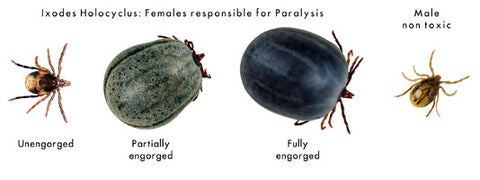PETS AND TICKS

In Australia, pets can be infested with several ticks including the brown dog tick, the bush tick, the kangaroo and the paralysis tick. (click here for Australian tick information) Pets are very susceptible to tick bites and some tickborne diseases.
Those living in rural and semi-rural areas with a hot and humid climate are most at risk, however, ticks can be found in cities, towns, parks and the suburbs.
If you are uncertain about the ticks in your area, please contact your local veterinarian.
All ticks can transmit diseases to animals and may cause debilitating diseases in pets including.
- Anaplasmosis
- Rikettisa
- Tick Fever
- Bartonella
- Lyme like disease
- Q fever
- Babesia Canis
- Borrelia and more
Tick Paralysis
In Australia, the paralysis tick (Ixodes holocyclus) is the most dangerous tick for pets taking just a few hours for tick diseases to be transmitted.
Around 10,000 dogs are affected each year, with a mortality of approximately 5 per cent. This means around 500 dogs will die every year, with the remainder undergoing discomfort and suffering.
Paralysis ticks are dangerous parasites that can attach to an animal, and as they drain the blood, they secrete a toxin which affects the animal’s nervous system. The toxin causes serious illness and is potentially fatal.

Image via Creature Clinic Australia
The paralysis tick can look different depending on whether they are engorged with blood or not. Tick awareness is the key. Become familiar with the ticks in your area. Connect with your local vet and search the internet for photos of paralysis ticks during different stages of life and engorgement. ‘Ixodes holocyclus’.
Once on the animal, the tick finds a place to attach where it firmly embeds its barbed mouth (hypostome) in the skin. When an adult tick feeds it increases in size dramatically, and the attachment site becomes red and swollen. The red swollen area may also be considered evidence of a prior tick attachment.
Signs of Tick Paralysis
- Breathing difficulties
- Coughing
- Vomiting
- Progressive muscle weakness throughout the body
- Loss of coordination in the hind legs or not being able to get up
- A change in the sound of the bark or voice
- Retching, coughing (sometimes it is a moist cough), vomiting
- Excessive salivation/drooling
- Loss of appetite
- Difficulty breathing or rapid breathing ( due to heart damage)
- Grunting noises when breathing
- Other abnormal behaviour
IF YOUR PET DISPLAYS ANY OF THESE SIGNS TAKE THEM TO A VET IMMEDIATELY.
Prevention checklist for your pets
- There are many products on the market designed to protect your pets against ticks and fleas. They range from washes, collars, sprays, tablets and are available in many outlets including vets, pets stores and online.
- Most of the available products are chemical based, and if your pet is sensitive they may not be suitable.
-
Insect Shield supply:
Insect Shield dog beds, blankets, bandanas, gaiters and tee’s with built-in, EPA-registered Insect Shield protection. - Alternatives to chemicals are non-toxic tick prevention products such as plant-based repellents, soaps, shampoos, essential oils and herbal supplements.
- Never apply Permethrin directly to cats since it is highly toxic to them. "
- Natural alternatives for pets, Dr. Karen Becker.
- Veterinarian Dr. Karen Becker on the "Benefits of Herbal Repellents".
- Tick Encounter Resource Centre from the USA
- The "Big Tick Project" in the UK.
AVOID THE TICK HABITAT
- During the tick season, avoid walking in high-risk areas known to harbor ticks.
- If your dog has visited areas that are known for ticks or are frequented by possums and bandicoots, check them immediately.
- Keep lawns and shrubs short and remove compost material from backyards.
- Apply tick control products when walking with your dog, travelling, or spending time outdoors.
- Make sure you have your TickEase tweezers with you at all times.
HOW TO CHECK YOUR PETS FOR TICKS
- Always check all the crevices, ticks like to hang out in dark areas where they are well hidden.
- Ticks can crawl but their main mode of transportation is hitchhiking. That means your pets can bring ticks inside the house. If you have a pet that goes outdoors, they can bring ticks into your house.
- Search your pets thoroughly at least once a day.
- Remove any collars before you start.
- Use your fingertips to feel through the animal’s coat.
- Ticks or tick craters can be felt as lumps on the skin’s surface.
- Part the hair and look at it more closely or with the help of a magnifying glass, if necessary. Your TickEase includes a bonus magnifier in the packaging.
- The place where the tick attaches may or may not be painful to your pet.
- There may be skin swelling.
- Most ticks are found forward of the front legs, especially on the face, neck, and ears. However, it is very important to search your entire pet, remembering to check under the armpits.
- Carefully examine all skin folds.
- Remember to check between each toe and under the surface of the front feet, behind the ears, in the ears, and in the mouth.



Pets can bring ticks and their eggs into your home, ending up in the carpet, furniture, bed, and on you and your family!
Dan the tick man removes tick from a dog with TickEase
